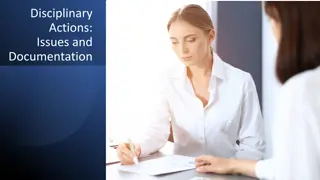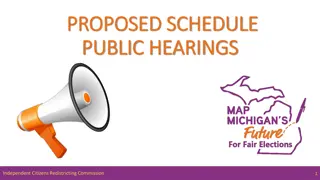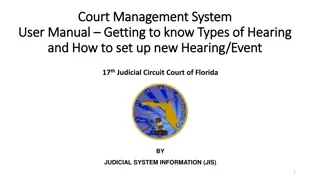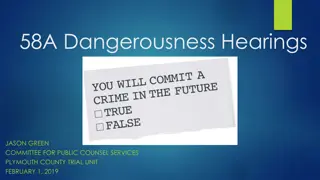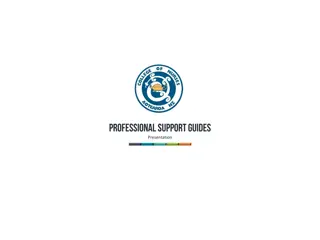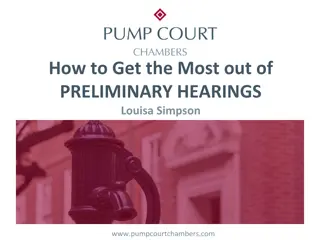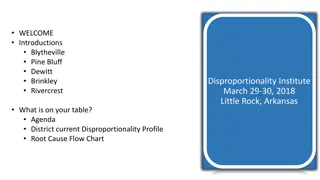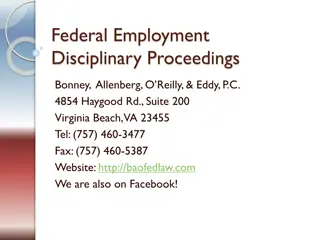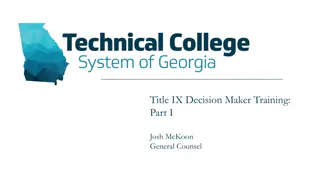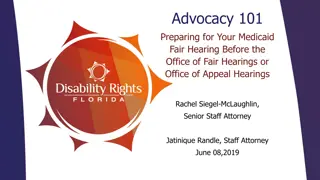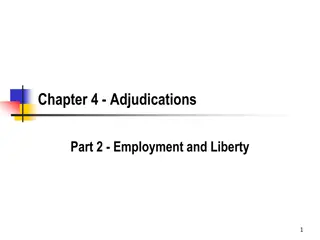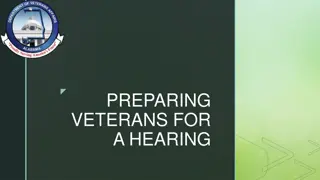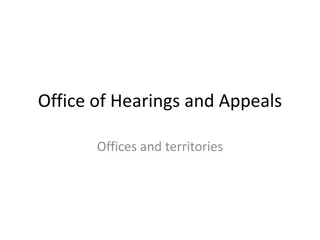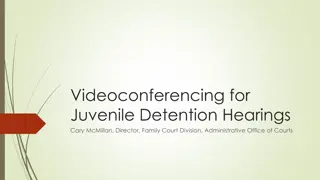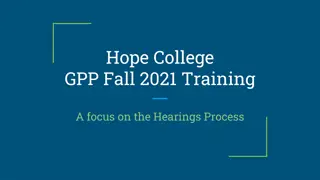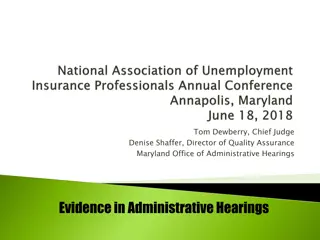Navigating School Board Disciplinary Hearings: Strategies for Success
Prevail in school board disciplinary hearings with expert advice from Beverly Brown, Ph.D., Esq. Explore the challenges of disparate discipline practices, understand compulsory attendance laws, and discover effective school responses to student behavior. Learn about due process, privileges, poverty impacts, and interventions such as RtI and FBA. Empower yourself with knowledge to navigate the quasi-judicial realm of school discipline.
Download Presentation

Please find below an Image/Link to download the presentation.
The content on the website is provided AS IS for your information and personal use only. It may not be sold, licensed, or shared on other websites without obtaining consent from the author. Download presentation by click this link. If you encounter any issues during the download, it is possible that the publisher has removed the file from their server.
E N D
Presentation Transcript
Kangaroo Court: How to prevail under the quasi-judicial nightmare of School Board disciplinary hearings, disparate, and archaic discipline practices Beverly Brown, Ph.D., Esq. Three Rivers Legal Services, Inc. bev.brown@trls.org
Agreement As children we all made mistakes (or else you are a hypothetical legal construct like the reasonable person) Some of them for which we did not get caught (whew) Many times we did not perceive the consequences Many times the risk may have outweighed what we perceived the cost (impulsivity/invincibility) Times have changed (zero tolerance, technology) Privilege and poverty play a role in outcomes
Advance Organizer Compulsory attendance Disciplinary exclusion Types Challenges The statistics The science Due Process What is supposed to happen
Advance Organizer (cont.) What frequently happens Schools responsibilities in response to behavior Response to Intervention (RtI)MTSS/PBIS 504 Child Find (IEP) Functional Behavior Assessments (FBA) and Behavior Intervention Plan (BIP) Manifestation Determination
http://tse1.mm.bing.net/th?id=OIP.M41055b76b048024daefb6a2b314ff064H0w=300h=225c=0pid=1.9rs=0p=0r=0http://tse1.mm.bing.net/th?id=OIP.M41055b76b048024daefb6a2b314ff064H0w=300h=225c=0pid=1.9rs=0p=0r=0
Compulsory Attendance 1003.21 children who have attained the age of 6 years or who will have attained the age of 6 years by February 1 of any school year or who are older than 6 years of age but who have not attained the age of 16 years, except as otherwise provided, are required to attend school regularly during the entire school term. School attendance. (1)(a)1. All
A student who attains the age of 16 years during the school year is not subject to compulsory school attendance beyond the date upon which he or she attains that age if the student files a formal declaration of intent to terminate school enrollment with the district school board. Public school students who have attained the age of 16 years and who have not graduated are subject to compulsory school attendance until the formal declaration of intent is filed with the district school board. The declaration must acknowledge that terminating school enrollment is likely to reduce the student s earning potential and must be signed by the student and the student s parent. The school district shall notify the student s parent of receipt of the student s declaration of intent to terminate school enrollment. The student s certified school counselor or other school personnel shall conduct an exit interview with the student to determine the reasons for the student s decision to terminate school enrollment and actions that could be taken to keep the student in school. The student s certified school counselor or other school personnel shall inform the student of opportunities to continue his or her education in a different environment, including, but not limited to, adult education and high school equivalency examination preparation. Additionally, the student shall complete a survey in a format prescribed by the Department of Education to provide data on student reasons for terminating enrollment and actions taken by schools to keep students enrolled.
The Reality-Educating your child is constitutionally protected Public School (Principal told me not to come back) Charter Private FLVS or other online options Public home school Private home school (little known sort of scary option) umbrella or 600 schools
Some exceptions Disabled children begin at 3 and some stay until 22ndbirthday Some even before age 3 (those with severe disabilities) McKinney Vento Act-for Homeless Youth or Youth in Transition, 42 U.S.C. 11431-11435
Fla. Stat. 1003.21 (e) children with disabilities who have attained the age of 3 years shall be eligible for admission to public special education programs and for related services. Children with disabilities younger than 3 years of age who are deaf or hard of hearing, visually impaired, dual sensory impaired, orthopedically impaired, or other health impaired or who have experienced traumatic brain injury, have autism spectrum disorder, have established conditions, or exhibit developmental delays or intellectual disabilities may be eligible for special programs and may receive services in accordance with rules of the State Board of Education. Rules for the identification of established conditions for children birth through 2 years of age and developmental delays for children birth through 5 years of age must be adopted by the State Board of Education. Consistent with rules adopted by the State Board of Education,
4) evidence that the child has attained the age at which he or she should be admitted in accordance with the provisions of subparagraph Before admitting a child to kindergarten, the principal shall require (1)(a)2. The district school superintendent may require evidence of the age of any child whom he or she believes to be within the limits of compulsory attendance as provided for by law. If the first prescribed evidence is not available, the next evidence obtainable in the order set forth below shall be accepted:(a) A duly attested transcript of the child s birth record filed according to law with a public officer charged with the duty of recording births; (b) A duly attested transcript of a certificate of baptism showing the date of birth and place of baptism of the child, accompanied by an affidavit sworn to by the parent; (c) An insurance policy on the child s life that has been in force for at least 2 years; (d) A bona fide contemporary religious record of the child s birth accompanied by an affidavit sworn to by the parent; (e) A passport or certificate of arrival in the United States showing the age of the child; (f) A transcript of record of age shown in the child s school record of at least 4 years prior to application, stating date of birth; or
Fla. Stat. 1003.21 (g) affidavit of age sworn to by the parent, accompanied by a certificate of age signed by a public health officer or by a public school physician, or, if these are not available in the county, by a licensed practicing physician designated by the district school board, which states that the health officer or physician has examined the child and believes that the age as stated in the affidavit is substantially correct. Children and youths who are experiencing homelessness and children who are known to the department, as defined in s. 39.0016, shall be given temporary exemption from this section for 30 school days. If none of these evidences can be produced, an
Disciplinary Exclusions-Types Corporal Punishment In-school Restraints and Seclusions (time outs) Out-of-School Alternative school Baker Acts Arrests Expulsion Silent push out (The come pick up your child or don t bring him/her back -quite common and no due process)
Corporal Punishment 1003.32 control of students; district school board and principal duties. Subject to law and to the rules of the district school board, each teacher or other member of the staff of any school shall have such authority for the control and discipline of students as may be assigned to him or her by the principal or the principal s designated representative and shall keep good order in the classroom and in other places in which he or she is assigned to be in charge of students. Authority of teacher; responsibility for
Differs across districts (k) least the following procedures, if a teacher feels that corporal punishment is necessary: 1. The use of corporal punishment shall be approved in principle by the principal before it is used, but approval is not necessary for each specific instance in which it is used. The principal shall prepare guidelines for administering such punishment which identify the types of punishable offenses, the conditions under which the punishment shall be administered, and the specific personnel on the school staff authorized to administer the punishment. 2. A teacher or principal may administer corporal punishment only in the presence of another adult who is informed beforehand, and in the student s presence, of the reason for the punishment. 3. A teacher or principal who has administered punishment shall, upon request, provide the student s parent with a written explanation of the reason for the punishment and the name of the other adult who was present. Use corporal punishment according to school board policy and at
Corporal Punishment in Florida Schools https://www.splcenter.org/20120901/corporal- punishment-florida-schools The belief that corporal punishment is a difficult, but necessary practice continues to persist in a minority of Florida school districts. It persists, even as administrators who support it say they are aware of its potential to damage children and that it may spark lawsuits. It persists even though corporal punishment has been found to increase youth hostility, antisocial behavior, and the likelihood that a child will drop out of school.
American Bar Association The American Bar Association opposes the use of corporal punishment in institutions where children are cared for or educated (p. 594). Institutional corporal punishment of children should be considered a form of child abuse that is contrary to current knowledge of human behavior and sound educational practices (p. 594).
American Academy of Child and Adolescent Psychiatry The American Academy of Child and Adolescent Psychiatry opposes the use of corporal punishment in schools.
National Association of Elementary School Principals Position Statement The NAESP believes that the practice of corporal punishment in schools should be abolished. Therefore, NAESP urges all educators, in cooperation with parents and other concerned citizens and associations, to promote legislation that would prohibit all forms of corporal punishment in schools and would provide resources for the development of positive alternatives for disruptive students.
National Association of Secondary School Principals NAASP believes that the practice of corporal punishment in schools should be abolished and that principals should use alternative forms of discipline (p. 2).
American Academy of Family Physicians The American Academy of Family Physicians is opposed to corporal punishment in schools. The Academy supports alternative methods of behavior management and modification in the school environment which enhances a student s optimal learning (p. 1).
National Association for the Education of Young Children Prohibit corporal punishment in schools and all other programs (p. 3). The institutional use of corporal punishment should never be condoned (p. 4).
Why CP Persists However, for many, The practice of hitting children as part of discipline is deeply embedded in religious beliefs, cultural views, government, law, and social policy (p. 198). In fact, 62% of adults and 61% of parents with small children view spanking as acceptable. These views regarding spanking in the home have been applied to discipline within schools.
District # Students Enrolled % of Students Experienci ng CP 9.90 9.36 8.66 6.25 5.06 4.74 4.06 3.81 3.42 3.30 2.69 2.26 1.94 1.81 1.61 1.46 1.43 1.20 1.07 1.04 0.77 0.44 0.39 0.26 0.25 0.22 0.18 0* Madison Holmes Washington Gulf Jackson Gilchrist Lafayette Suwannee Calhoun Walton Liberty Union Hardee Hendry Wakulla Santa Rosa Baker Levy Hamilton Dixie Glades Franklin Desoto Putnam Highlands Clay Nassau Marion 2553 3332 3485 1520 7070 2636 1157 5403 2248 7290 1263 2255 5036 6795 4817 24381 5004 5499 1667 2018 1163 1350 4533 11211 11936 35510 11054 41455
Recommendations 1. Discontinue the use of CP in FL schools immediately. 2. Continue to collect, analyze, and act on data related to the disproportionate use of other punishments with subgroups of students even after the discontinuation of CP. 3. Develop policies and interventions to address school discipline in a proactive and positive manner for all groups of students. 4. Provide ongoing professional development (PD) to help educators, school staff, and administrators implement evidence-based alternatives to CP and other ineffectual punishments.
1006.07 to student discipline and school safety District school board duties relating (2) elementary schools and a code of student conduct for middle and high schools and distribute the appropriate code to all teachers, school personnel, students, and parents, at the beginning of every school year. Each code shall be organized and written in language that is understandable to students and parents and shall be discussed at the beginning of every school year in student classes, school advisory council meetings, and parent and teacher association or organization meetings. Each code shall be based on the rules governing student conduct and discipline adopted by the district school board and shall be made available in the student handbook or similar publication. Each code shall include, but is not limited to:(a) Consistent policies and specific grounds for disciplinary action, including in-school suspension, out-of-school suspension, expulsion, and any disciplinary action that may be imposed for the possession or use of alcohol on school property or while attending a school function or for the illegal use, sale, or possession of controlled substances as defined in chapter 893 CODE OF STUDENT CONDUCT. Adopt a code of student conduct for
In-School Suspension: a Better Alternative or Waste of Time? May 4, 2012 | 9:00 AM By Sarah Gonzalez More than 455,000 Florida students were suspended last school year. Some of the student actually don t mind going there because they can sit there and do nothing. - Jennifer Smith, Hialeah High School teacher The majority more than 243,000 were in-school-suspensions. Students are held in a classroom away from other students. It could be for on class period, an entire school day, or multiple school days. Each school handles in-school suspensions differently. In Miami-Dade County, certified teachers supervise suspended students and act as tutors if students have questions. In Orange County, schools hire separate staff at a lower salary than beginning teachers. In Duval County, schools sometimes re-purpose staff to watch over in- school-suspension students.
States With the Most Secondary Suspension Rates http://www.huffingtonpost.com/2015/02/23/state-suspension- rates_n_6733134.html
(a) accordance with the provisions of s. 1006.09(1)-(4):1. A student may be suspended only as provided by rule of the district school board. A good faith effort must be made to immediately inform the parent by telephone of the student s suspension and the reason. Each suspension and the reason must be reported in writing within 24 hours to the parent by United States mail. A good faith effort must be made to use parental assistance before suspension unless the situation requires immediate suspension. 2. A student with a disability may only be recommended for suspension or expulsion in accordance with State Board of Education rules. Suspension of public school student. In
b) accordance with the rules of the district school board. The principal or the principal s designee shall make a good faith effort to immediately inform a student s parent by telephone of a student s suspension and the reasons for the suspension. Each suspension and the reasons for the suspension shall be reported in writing within 24 hours to the student s parent by United States mail. Each suspension and the reasons for the suspension shall also be reported in writing within 24 hours to the district school superintendent. A good faith effort shall be made by the principal or the principal s designee to employ parental assistance or other alternative measures prior to suspension, except in the case of emergency or disruptive conditions which require immediate suspension or in the case of a serious breach of conduct as defined by rules of the district school board. Such rules shall require oral and written notice to the student of the charges and an explanation of the evidence against him or her prior to the suspension. Each student shall be given an opportunity to present his or her side of the story. No student shall be suspended for unexcused tardiness, lateness, absence, or truancy. The principal or the principal s designee may suspend any student transported to or from school at public expense from the privilege of riding on a school bus for violation of district school board transportation policies, which shall include a policy regarding behavior at school bus stops, and the principal or the principal s designee shall give notice in writing to the student s parent and to the district school superintendent within 24 hours. School personnel shall not be held legally responsible for suspensions of students made in good faith. The principal or the principal s designee may suspend a student only in
Why is this a problem? Missing instruction No relationship to behavior Causes drop outs Increases involvement with DJJ Silent push outs (avoid the notice requirements)
Restraint 1003.573 (1) incident report within 24 hours after a student is released from restraint or seclusion. If the student s release occurs on a day before the school closes for the weekend, a holiday, or another reason, the incident report must be completed by the end of the school day on the day the school reopens. (b) The following must be included in the incident report:1. of the student restrained or secluded. 2. The age, grade, ethnicity, and disability of the student restrained or secluded. 3. The date and time of the event and the duration of the restraint or seclusion. 4. The location at which the restraint or seclusion occurred. 5. A description of the type of restraint used in terms established by the Department of Education. Use of restraint and seclusion on students with disabilities. DOCUMENTATION AND REPORTING. (a) A school shall prepare an The name
f. guardian. (c) time manual or physical restraint or seclusion is used. Such notification must be in writing and provided before the end of the school day on which the restraint or seclusion occurs. Reasonable efforts must also be taken to notify the parent or guardian by telephone or computer e-mail, or both, and these efforts must be documented. The school shall obtain, and keep in its records, the parent s or guardian s signed acknowledgment that he or she was notified of his or her child s restraint or seclusion. (d) A school shall also provide the parent or guardian with the completed incident report in writing by mail within 3 school days after a student was manually or physically restrained or secluded. The school shall obtain, and keep in its records, the parent s or guardian s signed acknowledgment that he or she received a copy of the incident report. Evidence of steps taken to notify the student s parent or A school shall notify the parent or guardian of a student each
(c) to the district school superintendent the expulsion of any student who has committed a serious breach of conduct, including, but not limited to, willful disobedience, open defiance of authority of a member of his or her staff, violence against persons or property, or any other act which substantially disrupts the orderly conduct of the school. A recommendation of expulsion or assignment to a second chance school may also be made for any student found to have intentionally made false accusations that jeopardize the professional reputation, employment, or professional certification of a teacher or other member of the school staff, according to the district school board code of student conduct. Any recommendation of expulsion shall include a detailed report by the principal or the principal s designated representative on the alternative measures taken prior to the recommendation of expulsion. The principal or the principal s designee may recommend
6. or seclusion of the student. 7. The name of any nonstudent who was present to witness the restraint or seclusion. 8. A description of the incident, including: a. which the restraint or seclusion occurred. b. The student s behavior leading up to and precipitating the decision to use manual or physical restraint or seclusion, including an indication as to why there was an imminent risk of serious injury or death to the student or others. c. The specific positive behavioral strategies used to prevent and deescalate the behavior. d. What occurred with the student immediately after the termination of the restraint or seclusion. e. Any injuries, visible marks, or possible medical emergencies that may have occurred during the restraint or seclusion, documented according to district policies. The name of the person using or assisting in the restraint The context in
2) restraint or seclusion on students shall occur at the classroom, building, district, and state levels. (b) Documentation prepared as required in subsection (1) shall be provided to the school principal, the district director of Exceptional Student Education, and the bureau chief of the Bureau of Exceptional Education and Student Services electronically each month that the school is in session. (c) The department shall maintain aggregate data of incidents of manual or physical restraint and seclusion and disaggregate the data for analysis by county, school, student exceptionality, and other variables, including the type and method of restraint or seclusion used. This information shall be updated monthly. (d) The department shall establish standards for documenting, reporting, and monitoring the use of manual or physical restraint or mechanical restraint, and occurrences of seclusion. These standards shall be provided to school districts by October 1, 2011. MONITORING. (a) Monitoring of the use of manual or physical
(3) develop policies and procedures that are consistent with this section and that govern the following:1. Incident-reporting procedures. 2. Data collection and monitoring, including when, where, and why students are restrained or secluded; the frequency of occurrences of such restraint or seclusion; and the prone or mechanical restraint that is most used. 3. Monitoring and reporting of data collected. 4. Training programs relating to manual or physical restraint and seclusion. 5. The district s plan for selecting personnel to be trained. 6. The district s plan for reducing the use of restraint and seclusion particularly in settings in which it occurs frequently or with students who are restrained repeatedly, and for reducing the use of prone restraint and mechanical restraint. The plan must include a goal for reducing the use of restraint and seclusion and must include activities, skills, and resources needed to achieve that goal. Activities may include, but are not limited to:a. Additional training in positive behavioral support and crisis management; b. Parental involvement; c. Data review; d. Updates of students functional behavioral analysis and positive behavior intervention plans; e. Additional student evaluations; f. Debriefing with staff; g. Use of schoolwide positive behavior support; and h. Changes to the school environment. SCHOOL DISTRICT POLICIES AND PROCEDURES. (a) Each school district shall
(b) which must be prepared as part of its special policies and procedures, must be filed with the bureau chief of the Bureau of Exceptional Education and Student Services no later than January 31, 2012. (4) PROHIBITED RESTRAINT. School personnel may not use a mechanical restraint or a manual or physical restraint that restricts a student s breathing. (5) SECLUSION. School personnel may not close, lock, or physically block a student in a room that is unlit and does not meet the rules of the State Fire Marshal for seclusion time-out rooms. Any revisions to the district s policies and procedures,
Alternative Schools 1003.04. Student conduct and parental involvement. (2) The parent of each public K-12 student must cooperate with the authority of the student s district school board, superintendent, principal, teachers, and school bus drivers, according to ss.1003.31 and 1003.32, to remove the student from the classroom and the school bus and, when appropriate and available, to place the student in an alternative educational setting, if the student is disobedient, disrespectful, violent, abusive, uncontrollable, or disruptive. 1006.13. Policy of zero tolerance for crime and victimization (3) District school boards may assign the student to a disciplinary program for the purpose of continuing educational services during the period of expulsion.
Zero Tolerance 3) have committed one of the following offenses to be expelled, with or without continuing educational services, from the student s regular school for a period of not less than 1 full year, and to be referred to the criminal justice or juvenile justice system.(a) weapon, as defined in chapter 790, to school, to any school function, or onto any school-sponsored transportation or possessing a firearm at school. (b) Making a threat or false report, as defined by ss. 790.162 and 790.163, respectively, involving school or school personnel s property, school transportation, or a school-sponsored activity. Zero-tolerance policies must require students found to Bringing a firearm or
Notwithstanding any other provision of law, each district school board shall adopt rules providing that any student found to have committed any offense in s. 784.081(1), (2), or (3) shall be expelled or placed in an alternative school setting or other program, as appropriate. Upon being charged with the offense, the student shall be removed from the classroom immediately and placed in an alternative school setting pending disposition. (6)(a) Notwithstanding any provision of law prohibiting the disclosure of the identity of a minor, whenever any student who is attending a public school is adjudicated guilty of or delinquent for, or is found to have committed, regardless of whether adjudication is withheld, or pleads guilty or nolo contendere to, a felony violation of: 1. Chapter 782, relating to homicide; 2. Chapter 784, relating to assault, battery, and culpable negligence; 3. Chapter 787, relating to kidnapping, false imprisonment, luring or enticing a child, and custody offenses; 4. Chapter 794, relating to sexual battery; 5. Chapter 800, relating to lewdness and indecent exposure; 6. Chapter 827, relating to abuse of children; 7. Section 812.13, relating to robbery; 8. Section 812.131, relating to robbery by sudden snatching; 9. Section 812.133, relating to carjacking; or 10. Section 812.135, relating to home-invasion robbery,
Due Process During Expulsion Expulsion hearings shall be governed by ss. 120.569 and 120.57(2) and are exempt from s. 286.011. However, the student s parent must be given notice of the provisions of s. 286.011 and may elect to have the hearing held in compliance with that section. The district school board may prohibit the use of corporal punishment, if the district school board adopts or has adopted a written program of alternative control or discipline. (b) Require each student at the time of initial registration for school in the school district to note previous school expulsions, arrests resulting in a charge, and juvenile justice actions the student has had, and have the authority as the district school board of a receiving school district to honor the final order of expulsion or dismissal of a student by any in-state or out-of-state public district school board or private school, or lab school, for an act which would have been grounds for expulsion according to the receiving district school board s code of student conduct, in accordance with the following procedures:1. expulsion shall be recorded in the records of the receiving school district. 2. The expelled student applying for admission to the receiving school district shall be advised of the final order of expulsion. A final order of





